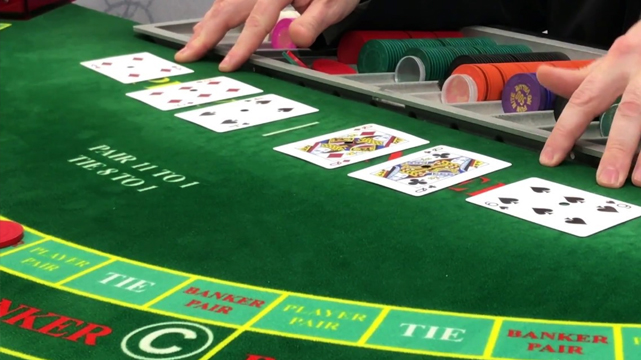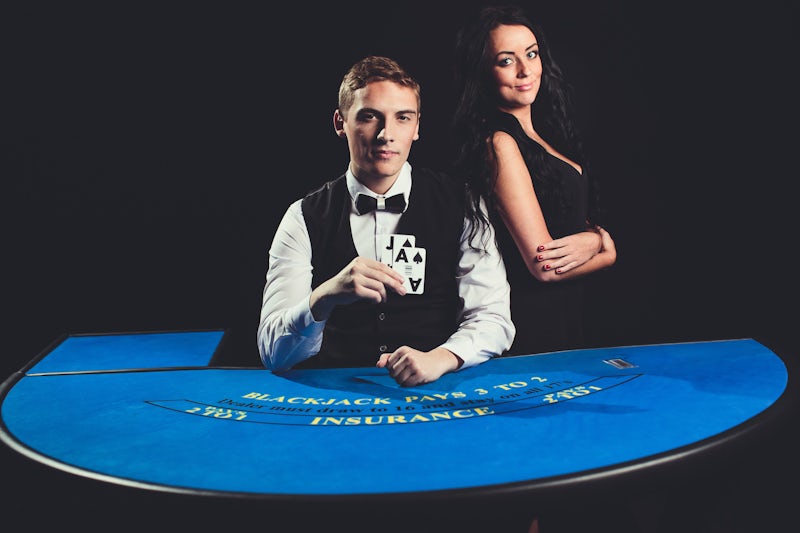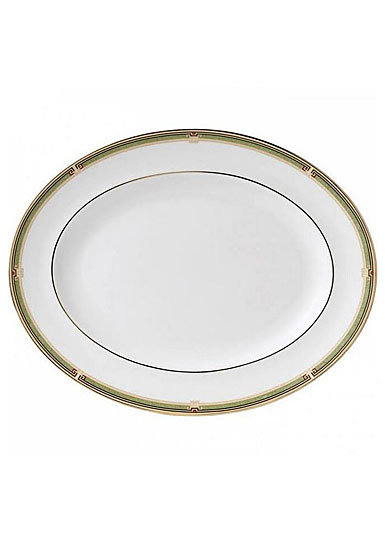- Standard Baccarat odds that you read about most places are based on a fresh, eight-deck shoe. This is the standard shoe that's used in the vast majority of Baccarat games in the land-based casino world. An eight-deck game has a 1.06% house edge on the banker bet with a 1.24% house advantage on the player bet.
- Baccarat is one of the oldest and most popular games played in all the casinos around the world, and it is also sometimes referred to as punto banco, so. Baccarat - Wizard of Odds - Wizard of Odds The Wizard of Odds.
On a regular baccarat table, house odds range from 1.01 to 1.24 percent on the BANKER and PLAYER bets. Many baccarat tables have higher limits than the other table games do. But don’t get scared away by a $25 or $50 minimum bet.
Another name for baccarat is “punto banco”. It doesn’t matter which name you prefer. It’s still one of the most classic examples of a casino game in history.
Baccarat is hugely popular with the Asian gambling community. It’s also a mainstay for casino whales and high stakes gamblers. In Macau, baccarat has the same kind of popularity that slot machines have here in the United States.
But some quick analysis of the math and odds behind the game reveals that it’s just a simple guessing game where you have an almost 50/50 chance of winning.
A Baccarat Tutorial: The Basics of How to Play
You’ll find 2 kinds of baccarat available:
- Traditional baccarat – This is the high stakes version of the game you’ll find in high limit areas of casinos throughout the world. This is the version of the game James Bond used to play (before Daniel Craig). It’s played at a big table with 3 dealers and usually a dozen or so players.
- Mini baccarat – This is the same game but with lower stakes. This version of the game runs faster and is played at a smaller table, although some mini baccarat games (called “midi baccarat”) are played for higher stakes at a larger table.
Both versions of the game are played using the same rules, although some of the details can vary.
In some ways, baccarat resembles blackjack. The cards have point values, and multiple decks are used (usually 8, but sometimes 6). But the card values are different from blackjack, as follows:
- Aces are worth 1 point (not 1 or 11 as in blackjack).
- 10s and jacks are worth 0 points (not 10 as in blackjack).
- All the other cards have a point value equal to their rank, just like in blackjack. For example, the 2 of spades is worth 2 points, the 3 of hearts is worth 3 points, etc.
The cards are dealt from a shoe, just like in blackjack. Every time the dealer starts a new shoe, she turns over a card. The point value of the card is the number of cards the dealer burns before dealing. (Except for 10s and face cards. For purposes of deciding how many cards get burned, these count as 10.)

The game uses a cut card, which is put 16 cards from the last card in the shoe. The cut card is the signal to the dealer that it’s time to start over with a new shoe. The new shoe doesn’t start until after the hand where it appears is completed and one additional subsequent hand are dealt.
You start by making one of the following 3 bets:
- Player
- Banker
- Tie
Some games offer 2 additional bets:
- Player pair
- Baker pair
Then the dealer gives the player 2 cards and the banker 2 cards. The score for each hand is calculated by totaling the point values of the cards. The right-most digit is what determines the score.
The player gets a 9 and an 8, which is a total of 17. That’s treated as a total of 7.
Here’s another example:
The banker gets a 5 and a 2, which is a total of 7. That’s also treated as a total of 7.
It’s impossible to bust.
You only have 10 possible scores: 0, 1, 2, 3, 4, 5, 6, 7, 8, or 9.
The action doesn’t necessarily end there (but it might). The player and/or the banker might get a 3rd card. The game has elaborate rules for how this is decided, too:
If the player OR the banker has a total of 8 or 9, that’s it. No one gets an additional card.


If neither the player nor the banker has a total of 8 or 9, the player gets another card if he has a total of between 0 and 5.
If the player DOESN’T get another card, and if the dealer has a score of between 0 and 5, the dealer gets an additional card.
If the player DOES get another card, the dealer might or might not get another card, based on the following rules:
- The banker always gets an extra card with a total of 2.
- The banker always gets an extra card with a total of 3 UNLESS the player’s 3rd card is an 8.
- The banker always gets an extra card with a total of 4, UNLESS the player’s 3rd card is a 0, 1, 8, or 9.
- The banker always gets an extra card with a total of 5, UNLESS the player’s 3rd card is a 0, 1, 2, 3, 8, or 9.
- The banker never gets an extra card with a total of 7 UNLESS the player’s 3rd card is a 6 or 7.
- The banker never gets an extra card with a total of 7.
You determine who the winner is by comparing the banker’s score with the player’s score. The higher score wins. The payoffs for each bet are different, though:
- Banker pays off at 19 to 20. (For example, if you bet $20 on the banker, you would win $19. If you bet $100 on the banker, you would win $95. But this isn’t how it’s actually handled at the table. The casino pays you even money on this bet, but they also give you a laminated marker for each 5% commission you owe. They collect that money before starting a shoe or any time the player decides to quit the game and cash out.)
- Player pays off at even money. (For example, if you bet $20 on the player, you would win $20. If you bet $100 on the player, you would win $100.)
- Ties pay off at 8 to 1. (For example, if you bet $20 on a tie, you would win $160.) Player and banker bets are treated as a push in the case of a tie. During a push, you get your original bet back with no winnings. In other words, you don’t lose anything or win anything.
- Pair bets pay off at 11 to 1. (For example, if you bet $20 on a pair, you’d win $220.)
Baccarat Odds, Probability, and House Edge
Given the above rules, it’s not hard to calculate the house edge for this game, but it’s probably worthwhile to explain the concept of the house edge.
The house edge is the amount of each bet that the casino expects to win on average over the long run. It’s expressed as a percentage.
In American roulette, the house edge is 5.26%.
Here’s how that amount is determined:
A roulette wheel has 38 numbers on it. 18 are black, 18 are red, and 2 are green.
If you bet on black or red, you get even money if you win.
If you place 38 bets of $100 each and get mathematically perfect results—landing on each number once—you’ll win 18 bets and lose 20 bets. At $100 each, that’s $1800 in winnings versus $2000 in losses, for a net loss of $200.
Average that $200 by the number of bets you made (38), and you see that you lost an average of $5.26 per bet.
In baccarat, the house edge varies based on which bet you place:
- The banker bet has a house edge of 1.06%
- The player bet has a house edge of 1.24%
- The tie bet has a house edge of 14.36%
- The pair bet has a house edge of 10.36%
Those numbers assume you’re playing in a game with 8 decks. If you’re playing in a game with 6 decks, the house edge is the same for the banker and player bets, but it goes up to 14.44% on the tie bet. The house edge on a pair bet also increases to 11.25%.
If you can find a single deck game, the house edge changes as follows:
- Banker, 1.01%
- Player, 1.29%
- Tie, 15.75%
- Pair, 29.5%
You might also find a casino which offers a baccarat game with a lower commission than 5% on the banker bet. If you can find such a game, this reduces the house edge significantly. At 4%, the house edge goes down to 0.6% in an 8 deck game. At 3%, the house edge is only 0.14%.
If you could find a game which offered the banker bet with no commission at all, you’d actually have an edge of 1.24% over the house. Good luck finding a game like that. Casino managers are good at casino game math, and they tend to avoid offering games to the public where the player gets an edge.
You might also find a casino which offers bigger payouts on player bets or tie bets. For example, you might find a casino that pays off at 1.01 to 1 on the player bet. That reduces the house edge for that bet to 1.04%, making it better than the banker bet.
Some casinos pay off 9 to 1 on a tie bet, too. This reduces the house edge on that bet to 4.84%.
Unless I indicated otherwise somewhere above, all these numbers are for a game with 8 decks.
Egalite Bets
One option I didn’t explain previously was an egalite bet. These bets are common in casinos in England, but rare or unheard-of everywhere else. An egalite bet is just a side bet on a specific event during a baccarat game. (It’s comparable to some of the bets available at the craps table.)
These bets and their payouts vary based on which casino you’re playing.
One common example is to be able to bet on a specific tie, like 0-0 or 1-1. These usually pay off at between 45 to 1 and 225 to 1, depending on the specific bet. (Some ties are more likely than others.)
A bet on 6 or 7 tie pays off at 45 to 1, and that’s the most likely tie to hit.
A bet on 2 pays off at 225 to 1. That’s the least likely tie to hit.
All these bets have one thing in common—a high house edge. None of them have a house edge of less than 10%, in fact.
Some casinos also allow you to bet on ranges, like 1-3 or 4-5. The payoffs for these are lower, of course, because you have more opportunities to win. A common payoff for a 1-3 egalite might be 70 to 1, but the house edge on that bet is still 10.86%.
Some of the ranges offer bet odds for the player, though. A 4-5 egalite has a house edge of just 7.28%. That’s still a lousy bet, but it’s not AS lousy.
Experienced casino players refer to a bet with a house edge this high as a “sucker bet”.
Baccarat Strategies, Tips, and Advice
Playing against a lower house edge is always better than playing against a higher house edge. That’s a gambling maxim you can take to your grave with you.
In the case of baccarat, the bet with the lowest house edge is the banker bet, so that’s the only bet you should make—ever.
Even if you’re playing a hunch, you should skip the tie bet or the pair bet. The house edge is too high.
If you believe in hunches, you might be able to make a case for a player bet. I don’t believe in hunches or luck, though.
I believe in math.
If you want an accurate strategy for baccarat, you can some it up in a single sentence:
You will find, though, that baccarat tables provide pencils and score cards so that you can follow the trends and adjust your betting accordingly.
This is a fool’s errand.
Yes, you’ll see winning streaks and losing streaks on a specific bet.
You’ll be tempted to ride that winning streak by switching your bet.
Or you’ll be tempted to bet the other way, assuming the dealer bet couldn’t possibly win again after having won so many times in a row.
Don’t bother.
Trends are only visible in hindsight. They have no effect on the future.
In fact, there’s even a phrase that explains this false belief. It’s called the gambler’s fallacy.
Blackjack players might wonder whether you can get an edge at baccarat by counting cards. Theoretically, this might be possible, but my understanding is that getting an edge would be very rare, and it wouldn’t be enough to get you an overall edge.
But blackjack players also have an advantage gambling method called “dealer tells”. This is when the dealer does something to indicate to the player the strength of their hand.
You don’t run into this exact same situation in baccarat, but you do occasionally run into a dealer who accidentally flashes the next card before you’re required to place your next bet.
If you know what the first card in a round of baccarat is, you get an advantage, and you can bet accordingly.
The Wizard of Odds has a chart detailing the bet with the best expectation based on which card gets flashed. Here are the correct bets based on the exposed card:
- 0, A, 2, 3, 4, or 5 – Bet on the banker.
- 6, 7, 8, or 9 – Bet on the player.
Odd Baccarat Meaning
The player’s edge over the casino in this situation comes to 6.76%, which is a huge edge to have over the casino.
Here’s a word of advice for novices, too:
If you notice this happening at the baccarat table, be discreet. If the casino figures out what you’re up to, they’ll adjust accordingly, and you’ll lose whatever you might have gained.
EZ Baccarat and Counting Cards
EZ Baccarat is a variation where you get paid even money on a banker bet and don’t have to pay commission. To make up for this, the casino considers a win when the banker has a total of 7 with 3 cards a push instead of a win.
They also add 2 additional side bets:
- The Panda 8 Bet – This bet pays off at 25 to 1 if the banker has a 3-card total of 8.
- The Dragon 7 Bet – This bet pays off at 40 to 1 if the banker has a 3-card total of 7.
Play Baccarat Online For Practice
The house edge for the Panda 8 bet is 10.19%.
In this game, you can use card counting to get an edge. Read our detailed guide to card counting for an explanation of why counting cards works in blackjack. With a little imagination, you can see how it would also be applicable to EZ Baccarat.
Wizard Of Odds Baccarat Game
Here are the card values to use:
- 0, 1, and 2 count as +1
- 3, 4, 5, and 8 count as -2
- 6 and 7 count as -1
- 9 counts as +4
When the count gets over 11, you have a slight advantage (0.01% or 0.02%) over the casino.
But it might be fun if you’re into that sort of thing.
You can read more about card counting with these side bets at Discount Gambling.
Conclusion

Baccarat is a fun, slow-paced, elegant game that requires no skill on the part of the player. If you can remember to always bet on the banker, you can play a game with a relatively low house edge and have a lot of fun.
If you want to get an edge at EZ Baccarat, you can pull it off by counting cards. You might also be able to find a dealer who’s flashing her cards while she deals. That can get you an edge, too.
Both scenarios require more effort than their worth, though. If you want to become an advantage player, I still think your best bet is to learn to count cards in blackjack.

- Welcome to the #1 Gambling Community with the best minds across the entire gambling spectrum. REGISTER NOW!
- Join our $5,000 Cash Giveaway!
Win Cash by Posting and Inviting New Members! - Have a gambling question?Dismiss Notice
Post it here and our gambling experts will answer it! - Discussions in this section are assumed to be EV- as they are outside of the Advantage Play section. For EV+ discussions, please visit the Advantage Play sub-forum.Dismiss Notice
Discussion in 'Baccarat Forum' started by Zhang Wei, Dec 21, 2020.
Advertise with us.